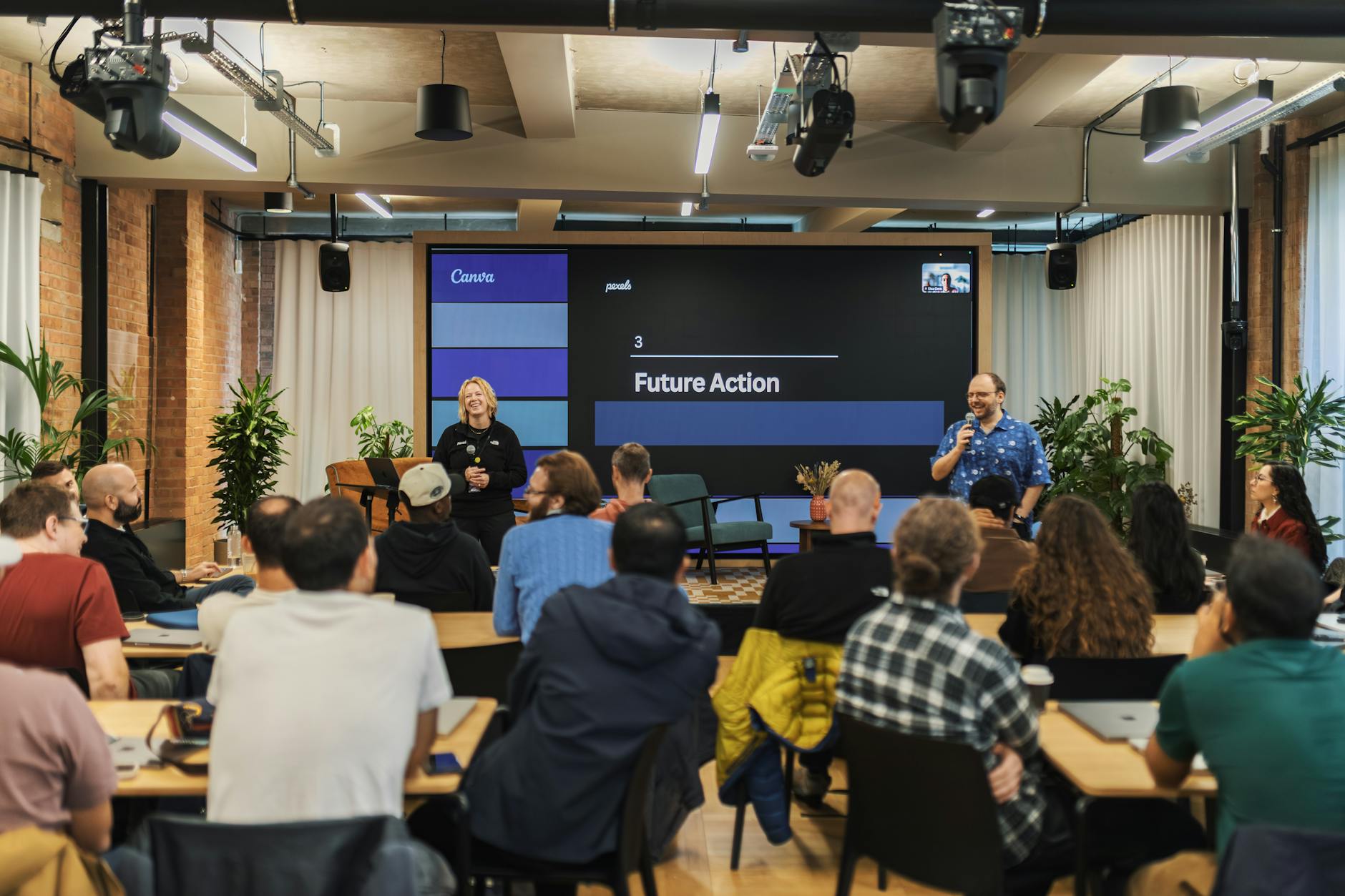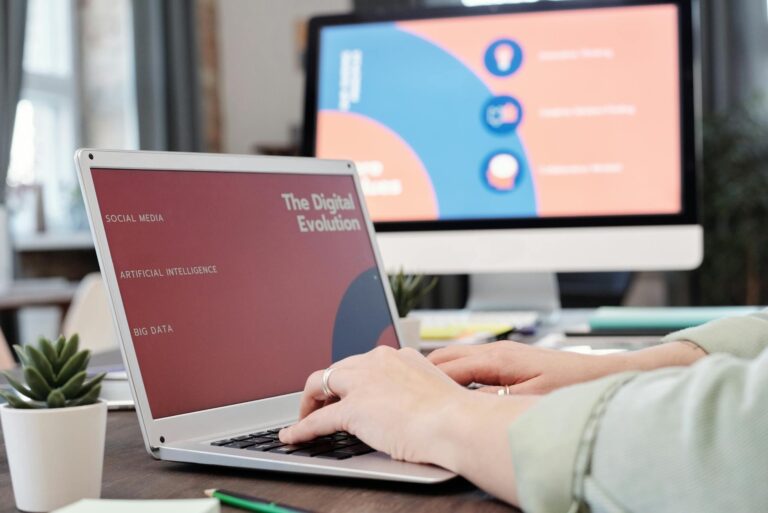Essential 2025 Tech Trends for Business Success
The 2025 Tech Playbook: Navigating Cutting-Edge Web Development, Mobile Innovation, Cloud, AI Automation, and Modern UI/UX Trends
Estimated reading time: 10 minutes
Key Takeaways
- Web Development in 2025 will prioritize speed and intelligence with Next.js/React, headless CMS, and AI integrations for enhanced user experiences.
- Mobile App Innovation focuses on delivering seamless, high-performance cross-platform experiences using frameworks like Flutter and React Native, alongside intuitive and accessible UI/UX design.
- Cloud & DevOps practices are converging to offer unparalleled agility and scalability through serverless architecture and streamlined CI/CD automation, reducing operational costs.
- AI Automation is transforming business operations by leveraging intelligent chatbots, no-code workflow tools (like n8n), and advanced AI applications for increased efficiency and strategic delegation.
- Modern UI/UX Design goes beyond aesthetics, emphasizing responsive, adaptive, and accessible experiences as a critical differentiator and business imperative.
Table of Contents
- Decoding the Digital Future: Key 2025 Tech Trends for Business Transformation
- 1. The Evolution of Web Development: Speed, Scalability, and Intelligence
- 2. Mobile App Innovation: Cross-Platform Excellence and UI Prowess
- 3. Cloud Computing and DevOps: Agility, Scalability, and Cost Efficiency
- 4. AI Automation for Businesses: Intelligent Efficiency and Delegation
- 5. Modern UI/UX Design: Beyond Aesthetics to Experience
- 6. Digital Transformation Strategies: Empowering Businesses of All Sizes
- How AI TechScope Helps You Navigate the 2025 Tech Landscape
- Ready to Transform Your Business with 2025 Tech Trends?
- FAQ
The digital landscape is in perpetual motion, constantly reshaped by groundbreaking innovations and evolving user expectations. For business leaders, entrepreneurs, and tech-forward professionals, understanding the pulse of these changes is not merely advantageous—it’s existential. As we look towards 2025, a clear set of 2025 tech trends is emerging, promising to redefine how businesses operate, engage with customers, and drive growth. This comprehensive guide will dissect the future of web development, mobile app innovation, cloud and DevOps practices, AI automation, and modern UI/UX design, equipping you with the insights needed to accelerate growth, improve performance, and transform your company’s operational blueprint.
At AI TechScope, we believe that staying ahead of these trends requires not just awareness, but strategic implementation. Our expertise in AI-powered automation, n8n workflow development, and comprehensive AI consulting services positions us as your ideal partner in leveraging these technologies for unparalleled efficiency and competitive advantage.
Decoding the Digital Future: Key 2025 Tech Trends for Business Transformation
The upcoming year promises a suite of advancements that will profoundly impact businesses across all sectors. From the foundational infrastructure of the web to the intricate design of user experiences, every layer of the digital ecosystem is undergoing a significant transformation. Let’s explore the critical 2025 tech trends that demand your attention.
1. The Evolution of Web Development: Speed, Scalability, and Intelligence
Web development is no longer just about creating a presence; it’s about delivering lightning-fast, highly interactive, and intelligent experiences. The emphasis has shifted towards performance, scalability, and developer efficiency.
Next.js and React: Performance at the Core
The demand for blazing-fast websites is paramount for SEO, user engagement, and conversion rates. Frameworks like Next.js, built on React, are leading this charge. Next.js, with its server-side rendering (SSR), static site generation (SSG), and incremental static regeneration (ISR) capabilities, is becoming the go-to for building high-performance marketing sites and complex web applications.
For small businesses, leveraging Next.js means they can “Build a Fast Marketing Site in One Weekend,” significantly reducing time-to-market and instantly gaining an edge in search rankings and user satisfaction. This performance focus extends to general React applications, where “5 Simple React Performance Fixes” can drastically “Reduce Page Load by Seconds,” directly impacting bounce rates and user experience. Optimizing component rendering, using memoization, and lazy loading are no longer optional but essential practices.
Headless CMS and Micro Frontends: Modularity and Flexibility
The traditional monolithic content management system (CMS) is giving way to more modular approaches. Headless CMS solutions, exemplified by using “WordPress Without the Bloat” (by decoupling the front-end), allow developers to use their preferred front-end frameworks while content is managed separately. This provides unparalleled flexibility, enabling content delivery across various platforms (web, mobile, IoT) from a single source.
For larger enterprises or complex applications, “Micro Frontends” are gaining traction. This architectural style breaks down a monolithic front-end into smaller, independently deployable units. While they offer benefits in team autonomy, scalability, and technology diversity, it’s crucial to understand “When They Help and When They Hurt (Practical Examples).” They are ideal for large, distributed teams working on highly complex applications but can introduce overhead if not carefully managed.
AI-Powered Web Apps: The Next Frontier
The integration of AI into web applications is moving beyond simple chatbots. We’re seeing “AI-powered web apps” that offer personalized user experiences, predictive analytics, intelligent content recommendations, and dynamic UI adjustments based on user behavior. Imagine a SaaS product where AI “delights users” with “3 Low-Effort AI Features” like smart search, personalized dashboards, or automated content summaries. This elevates user engagement and operational efficiency.
- Practical Takeaway: Evaluate your current web stack. If you’re struggling with page load times, consider migrating to Next.js or implementing React performance optimizations. Explore headless CMS for greater content flexibility and consider AI integrations to personalize user experiences. AI TechScope specializes in developing high-performance, AI-enhanced web applications using Next.js and React, ensuring your online presence is both cutting-edge and efficient.
2. Mobile App Innovation: Cross-Platform Excellence and UI Prowess
Mobile apps remain a cornerstone of digital strategy, and the focus for 2025 is on delivering seamless, high-performance experiences across devices with efficient development cycles.
Flutter vs. React Native: The Cross-Platform Showdown
The debate of “React Native vs Flutter in 2025” continues, but both frameworks have matured significantly. For businesses looking to develop cost-effective, high-quality “mobile app development 2025” solutions that reach both iOS and Android users, cross-platform development is key. Flutter, with its single codebase and native-like performance, is increasingly popular for “Building a Simple Cross-Platform App” from idea to app store. React Native, backed by Facebook, offers a strong ecosystem and JavaScript familiarity.
The choice “Which Is Best for Your Business App?” depends on factors like existing team skill sets, specific performance requirements, and desired UI complexity. Both enable faster development cycles and reduced maintenance overhead compared to native-only approaches.
Mobile App UI Trends: Intuition and Accessibility
Beyond performance, the user interface (UI) and user experience (UX) of mobile apps are critical. Trends include minimalist designs, dark modes, gesture-based navigation, and highly responsive, adaptive UIs. Crucially, “mobile app UI trends” emphasize accessibility. “Designing Accessible Buttons: A Non-Designer’s Guide (Figma Tips)” highlights the importance of inclusive design, ensuring apps are usable by everyone, regardless of ability. This not only broadens your audience but also reflects a commitment to ethical design.
- Practical Takeaway: If you’re planning a new mobile app, consider cross-platform frameworks like Flutter or React Native to optimize development costs and speed. Prioritize intuitive and accessible UI/UX design from the outset to ensure a broad, engaged user base. AI TechScope offers expert mobile app development services, helping you choose the right framework and design approach to build future-proof applications.
3. Cloud Computing and DevOps: Agility, Scalability, and Cost Efficiency
The backbone of modern digital operations lies in robust cloud infrastructure and agile development practices. “Cloud computing and DevOps” are converging to deliver unprecedented levels of scalability, reliability, and speed.
Serverless Architecture: The Cost-Efficient Scalability Engine
“Serverless architecture” is no longer a niche concept; it’s a mainstream strategy for startups and enterprises alike. Technologies like AWS Lambda allow businesses to “Create a Cost-Efficient Backend That Scales Automatically” without provisioning or managing servers. This “serverless AWS cost example” demonstrates how paying only for compute time consumed can dramatically reduce infrastructure costs, especially for applications with fluctuating traffic. It’s the ideal “serverless backend for startups” seeking to innovate rapidly without heavy upfront infrastructure investment.
CI/CD Automation: Streamlining Development Workflows
For development teams, “CI/CD automation” is non-negotiable. Continuous Integration and Continuous Delivery (CI/CD) pipelines, especially for “CI/CD for Small Teams: Automated Deployments Without the Headache,” drastically accelerate the software development lifecycle. Tools like GitHub Actions provide an accessible “GitHub Actions deploy tutorial,” enabling automated testing, building, and deployment with every code change. This reduces manual errors, speeds up release cycles, and frees developers to focus on innovation.
Cloud Migration and Microservices: Modernizing Legacy Systems
Many businesses grapple with legacy applications. A strategic “cloud migration strategy” is essential. The article “How to Move Your Legacy App to the Cloud Without Breaking It” provides a roadmap for a smooth transition, often involving containerization and a phased approach. Complementing this is “microservices architecture,” which breaks down applications into small, independent services. This enhances scalability, resilience, and allows different teams to work on different services autonomously, improving “DevOps best practices.”
- Practical Takeaway: Embrace serverless architecture for new projects or specific functionalities to maximize scalability and minimize operational costs. Implement CI/CD pipelines to automate your development and deployment processes, increasing efficiency and reducing errors. If you have legacy systems, start planning a phased cloud migration. AI TechScope offers expert AI consulting and DevOps guidance, including n8n workflow development, to help you build resilient, scalable, and cost-efficient cloud-native solutions.
4. AI Automation for Businesses: Intelligent Efficiency and Delegation
Artificial intelligence is rapidly moving from a theoretical concept to a practical tool that drives tangible business value. “AI automation for businesses” is poised to revolutionize operational efficiency, customer service, and strategic decision-making.
Chatbot Automation: Smarter Customer Interactions
“Chatbot automation” is evolving beyond basic FAQs. “How Small Businesses Use Chatbots to Save Time: Real Workflows That Work” illustrates how AI chatbots can handle routine customer inquiries, qualify leads, and even assist with sales, freeing human agents for more complex tasks. “AI chatbots for customer service” are becoming more sophisticated, understanding natural language nuances and providing personalized, instant support 24/7. This improves customer satisfaction and significantly reduces operational costs.
Workflow Automation Tools: Unleashing Productivity with No-Code AI
The power of AI is being democratized through “workflow automation tools” that integrate “no-code tools + AI.” Businesses can now “Automate Repetitive Tasks” using platforms like n8n, saving “5–10 Hours/Week” per employee. Imagine automatically categorizing emails, syncing data between disparate systems, or generating reports with AI assistance. This level of “intelligent delegation” allows teams to focus on high-value, strategic work, transforming internal processes.
Advanced AI Applications: Beyond the Basics
The scope of AI’s impact is broadening dramatically. Voice AI company ElevenLabs, for example, is now letting authors “create and publish audiobooks on its own platform,” using advanced text-to-speech capabilities. This demonstrates how AI is creating entirely new product categories and revenue streams, not just optimizing existing ones. For SaaS products, embedding “AI features that delight users” can be a key differentiator, making your offering “Smarter” and more competitive.
- Practical Takeaway: Identify repetitive tasks in your business that can be automated with AI-powered tools. Explore chatbot solutions for customer service and lead generation. Invest in workflow automation platforms to integrate AI into your daily operations. AI TechScope specializes in AI-powered automation and n8n workflow development, providing virtual assistant services that intelligently delegate tasks, optimize workflows, and drive significant cost reductions for your business.
5. Modern UI/UX Design: Beyond Aesthetics to Experience
User Interface (UI) and User Experience (UX) design are critical differentiators in a crowded digital marketplace. Modern design principles go beyond mere aesthetics, focusing on accessibility, intuition, and seamless interaction.
Responsive and Adaptive Design: The Standard Expectation
Users expect a consistent and optimal experience regardless of the device they use. “Responsive UI design” is the foundational approach, ensuring websites and applications fluidly adapt to different screen sizes. However, “modern UI/UX design” also embraces adaptive strategies, tailoring content and functionality more specifically to the device context, enhancing usability and engagement across desktops, tablets, and mobile phones.
Accessibility as a Core Principle:
Inclusivity is not just a buzzword; it’s a critical design and business imperative. Ensuring your digital products are accessible to users with disabilities broadens your audience and aligns with ethical design practices. As highlighted by “Designing Accessible Buttons: A Non-Designer’s Guide,” even small design choices can significantly impact usability for a wider range of users, from color contrast to keyboard navigation.
- Practical Takeaway: Prioritize responsive and adaptive design for all your digital properties. Integrate accessibility checks into your UI/UX design process from the earliest stages. A superior user experience can be a powerful competitive advantage. AI TechScope ensures all web and mobile solutions we develop adhere to the highest standards of modern UI/UX and accessibility.
6. Digital Transformation Strategies: Empowering Businesses of All Sizes
Underpinning all these trends is the broader theme of “digital transformation strategies.” It’s about leveraging technology to fundamentally change how a business operates, delivers value, and interacts with customers.
For small companies, “Digital Transformation on a Budget: 7 Steps Small Companies Can Start Today” provides an actionable blueprint. This includes adopting cloud-based tools, automating repetitive tasks, improving online presence, and leveraging data for decision-making. “Enterprise digital adoption” highlights the challenge of integrating new technologies across large organizations, emphasizing the need for strategic planning, change management, and phased implementation.
“Tech innovation for small businesses” is about strategically adopting tools that deliver immediate ROI and scalability. Whether it’s a “Next.js small business site” for faster lead generation, “AI-powered web apps” for personalized customer journeys, or “workflow automation tools” for internal efficiency, the goal is always to improve performance and accelerate growth.
- Practical Takeaway: Don’t view digital transformation as an overhaul, but a continuous journey. Start with clear objectives, identify bottlenecks, and adopt technologies that offer a clear path to efficiency and growth, even on a budget. AI TechScope provides expert AI consulting to guide businesses through their digital transformation journey, identifying key areas for optimization and implementing cutting-edge solutions.
How AI TechScope Helps You Navigate the 2025 Tech Landscape
The accelerating pace of technological change presents both immense opportunities and significant challenges. For businesses to thrive in this environment, strategic guidance and expert implementation are indispensable. AI TechScope is uniquely positioned to help your organization harness the power of these 2025 tech trends.
We empower businesses to:
- Optimize Workflows with AI Automation: Our specialization in AI-powered automation and n8n workflow development allows us to identify bottlenecks, design intelligent automation solutions, and integrate cutting-edge AI tools into your existing processes. This results in significant cost reductions, improved efficiency, and the liberation of your human talent for more strategic endeavors.
- Build Future-Proof Digital Platforms: From high-performance Next.js and React marketing sites to robust cloud-native applications and cross-platform mobile apps, our website development expertise ensures your digital presence is fast, scalable, secure, and user-centric, incorporating the latest in AI and modern UI/UX design.
- Achieve Digital Transformation: Through our comprehensive AI consulting services, we partner with you to develop tailored digital transformation strategies. We help you select the right tech stack, implement DevOps best practices, navigate cloud migration, and embed AI into your core operations, fostering enterprise digital adoption.
- Leverage Virtual Assistant Services: Our intelligent delegation and automation solutions extend to providing virtual assistant services powered by AI, optimizing everything from customer service with advanced chatbots to internal administrative tasks, enabling your business to scale operations without proportional cost increases.
The future of business is intrinsically linked to its ability to adapt and innovate with technology. Don’t let the complexity of emerging trends become a barrier. Let AI TechScope be your guide and implementer.
Ready to Transform Your Business with 2025 Tech Trends?
The digital world is evolving at an unprecedented pace. Proactive adoption of these 2025 tech trends is not merely an option, but a strategic imperative for sustained growth and competitiveness. From leveraging AI automation for businesses to building lightning-fast web and mobile applications, the opportunities to enhance efficiency, drive innovation, and improve customer experiences are boundless.
Don’t get left behind.
Contact AI TechScope today to explore our AI automation and consulting services. Let us help you develop a customized strategy that integrates these cutting-edge technologies, streamlines your operations, and positions your business for unparalleled success in the years to come.
Explore AI TechScope’s AI Automation and Consulting Services Now!
FAQ
- What are the major tech trends for businesses in 2025?
- How can web development improve performance in 2025?
- Which cross-platform frameworks are popular for mobile app development in 2025?
- How does serverless architecture benefit businesses?
- What role does AI automation play in business efficiency?
- Why is accessibility important in modern UI/UX design?
- How can small businesses approach digital transformation on a budget?
What are the major tech trends for businesses in 2025?
The key tech trends for 2025 include the evolution of web development focusing on speed and intelligence, mobile app innovation with cross-platform excellence and intuitive UI/UX, advanced cloud computing and DevOps for agility and scalability, widespread AI automation for efficiency and intelligent delegation, and modern UI/UX design emphasizing accessibility and seamless experience. Digital transformation strategies underpin the adoption of these trends across all business sizes.
How can web development improve performance in 2025?
Web development will improve performance through frameworks like Next.js (utilizing SSR, SSG, ISR), React performance optimizations (memoization, lazy loading), and modular architectures such as headless CMS and micro frontends. The integration of AI for personalized experiences and dynamic UI adjustments will also enhance engagement and efficiency.
Which cross-platform frameworks are popular for mobile app development in 2025?
Flutter and React Native remain the leading cross-platform frameworks for mobile app development in 2025. Both offer single codebase solutions for iOS and Android, enabling faster development cycles and reduced maintenance, with the choice often depending on existing team skills and specific project requirements.
How does serverless architecture benefit businesses?
Serverless architecture offers significant benefits by providing cost-efficient scalability. Businesses only pay for the compute time consumed, eliminating the need to provision or manage servers. This dramatically reduces infrastructure costs, especially for applications with fluctuating traffic, and allows startups to innovate rapidly without heavy upfront investment.
What role does AI automation play in business efficiency?
AI automation revolutionizes business efficiency by intelligently delegating tasks. This includes advanced chatbot automation for smarter customer service, no-code workflow automation tools (like n8n) for repetitive tasks, and deeper AI integrations for personalized experiences, predictive analytics, and even creating new product categories, freeing human talent for strategic work.
Why is accessibility important in modern UI/UX design?
Accessibility is a critical principle in modern UI/UX design because it ensures digital products are usable by everyone, including individuals with disabilities. This broadens the audience, aligns with ethical design practices, and often improves the overall user experience for all users by promoting clear, intuitive, and flexible interfaces.
How can small businesses approach digital transformation on a budget?
Small businesses can approach digital transformation on a budget by adopting cloud-based tools, automating repetitive tasks, improving their online presence with cost-effective solutions like Next.js marketing sites, and leveraging data for informed decision-making. The focus should be on strategic adoption of technologies that offer immediate ROI and scalability without extensive upfront investment.







